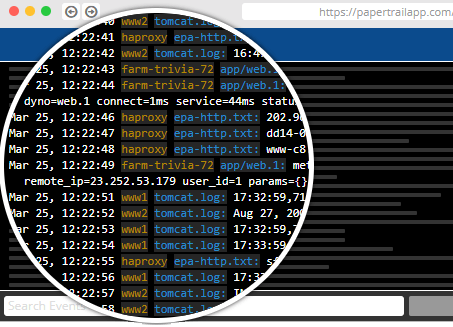SolarWinds Guides
By engineers, for engineers
At SolarWinds we are software engineers who are passionate about programming, debugging, logging and pretty much everything about building and running applications. We enjoy keeping our coding skills sharp and playing with new technologies. Below are some of things we have picked up along the way.
Fully Functional for 30 Days

Log4Net and Log4j
Django
Nginx
Python
Kubernetes
Ruby on Rails
Heroku
What Is DigitalOcean?
Docker: Everything You Need to Know
Log4Net and Log4j
Application logging is a big deal. Keeping track of software issues in production needs to be a priority because it helps you gain insight and monitor the performance of your applications. Ultimately, it helps maintain a healthy and sustainable app. Some reasons for logging data about software issues include enhancing security, debugging, and analytics.
Django
Lately, I’ve noticed developers are in a hurry to deliver the next big product idea. And most of the time, the product includes tasks such as user authentication, database connectivity, debugging, and performance monitoring. Frequently, developers have built these modules for other projects. But these modules weren’t architected to be reused, so the developers have to build them again. This means spending time repeating code, testing again, and debugging again. To address this issue, one framework in Python already has these types of modules and enables you to focus on your main task. Its name is Django, and in this article, I’ll show you how to start working with it. I’ll also go over its strong points and its weaknesses.
Nginx
One of the fundamental units of the internet is the web server. These web servers are computers built to deliver the requested webpage. Every web server has an IP address and a domain name. To make your computer a web server, you have to install web server software, such as NGINX, XAMPP, Apache, Tornado, Caddy, or Microsoft Internet Information Services (IIS). In this article, we’ll focus on NGINX.
Python
Python is one of the world’s most popular programming languages. Millions of developers worldwide use Python to do everything from writing basic scripts to building entire applications.
In this post, we’ll break down common use cases for Python and look at several ways you can take your Python usage from good to great.
Kubernetes
Containers have become the norm for creating standard applications. Clients and engineers don’t like downtime in the production environment, and recently, several organizations have adopted containers as a solution. The desire for scalable, high-performing applications that don’t experience downtime has led many to orchestration technologies like Kubernetes.
Ruby on Rails
Ruby on Rails, also known as Rails, is a popular framework suited to nearly any web application. Many well-known commercial sites, such as Airbnb, GitHub, Bloomberg, and Basecamp—the site it was created for—use it today.
Rails is known for its ease of use and scalability. You can get a site with a complete database back end up and running in minutes. The framework also makes deploying sites from development to production environments effortless.
Heroku
What Is Heroku?
Heroku is a platform as a service (PaaS) that allows developers to quickly build and deliver applications. Like other PaaS offerings, the Heroku platform manages the infrastructure and development environment, allowing developers to focus on creating and optimizing applications.
What Is DigitalOcean?
What Is DigitalOcean?
DigitalOcean is an Infrastructure-as-a-Service (IaaS) provider that introduced an application Platform-as-a-Service (PaaS) offering. Unlike strictly PaaS providers—such as Google App Engine or Heroku—DigitalOcean provides users with access to the underlying virtual machines that support their applications. Users can configure the disk space, memory allocation, networking settings, operating system, and more to best meet the needs of their application.
Docker: Everything You Need to Know
Docker is the most widely used container platform today. But what is Docker, and what do you need to know about it? How can Docker help you manage your IT infrastructure? Can it help you lower costs and improve uptime?
In this post, we’ll cover what Docker is, what it’s good for, and what it’s not so good for. Then, we’ll show you how to get started using it quickly.